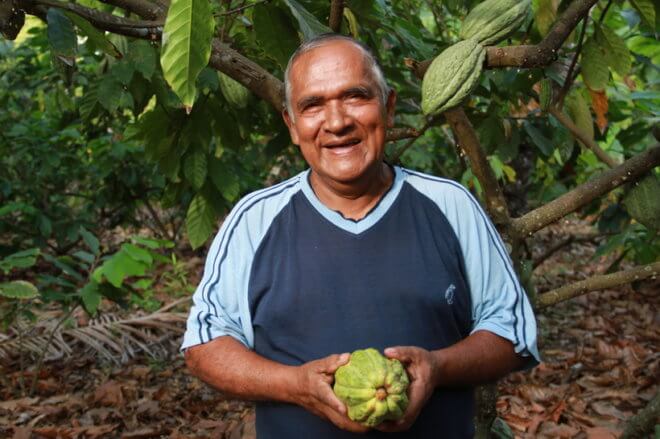The Washington Post recently published a provocative infographic about ethical chocolate and what those labels on your chocolate bar might mean. Included were three fair trade labels that originally aimed to empower marginalized farming communities in the most socially and economically disadvantaged parts of the world. Rainforest Alliance, a label with some basic social and environmental criteria, though not fair trade, was also included. The infographic “Your ethical chocolate might be only 20 percent ‘ethical’” is a great conversation starter, but begs for a deeper discussion of the complexities of supply chains in a multi-ingredient product and the differences in ethical claims.
My organization, Fair World Project, has for years worked on developing reference guides, online tools and reports to explain the complexity of certification standards. We, of anyone, understand how hungry consumers and retailers are for information that allows them to make informed decisions to purchase products that fit with their own values. And also how complicated these decisions can be. FWP has watchdogged the Fair Trade industry, insisting on transparency and activating consumers to make certifiers accountable to farmers needs and consumers’ expectations.

A certification label is one tool to help start to tell a story about a product. A Fairtrade America or Small Producer Symbol fair trade label on a bag of coffee assures me that a cooperative of small-scale producers benefited from my purchases. But with the proliferation of fair trade and competing claims made by different labels, the complexities of multi-ingredient products, and the dynamic of various companies adopting fair trade for various reasons ranging from ethical commitment to PR opportunities, it is not always that simple. For those reasons, labels should not be the only tool that someone looks at when making purchasing decisions but it is an important first step.
The Washington Post infographic highlights the differences among labels in some obvious and some more subtle ways. At first glance it might look like Fairtrade International/America and Fair Trade USA are identical. But this is not true. Fairtrade International/America is actually a much stronger certification than what the highlighted numbers (20% threshold of certified ingredients needed for using a label) let on. Fairtrade International has farmers sitting at the table in their governance structure, an important piece of a certification’s story because those that are impacted by policies need their leadership involved in developing those policies for them to be meaningful. Governance and decision-making structures are key pieces of empowerment that are impossible to tell from the label.
The text of the infographic under Fairtrade International’s multi-ingredient labeling policy states that “all that can be must be” certified. Which means all ingredients in a chocolate bar that Fairtrade International has standards for must be included. This is not the case with Fair Trade USA, which does not require important ingredients such as sugar, notorious for human and environmental exploitation, to be certified. The basics of the policies are accurately laid out in the infographic, but the reality of what that means is a little more startling.
Rainforest Alliance does not guarantee a minimum price or a price premium for community development for farmers and doesn’t even require all of a single ingredient to be certified, meaning a certified farmers’ cocoa could be mixed with conventional cocoa.
With few exceptions, any certification label speaks only about the product itself. Many small-scale farmers are so disadvantaged in the global economy that they accept any opportunity to sell product on fair trade terms. Which means in most cases, even if a product is only 20% fair trade (and I’m talking about fair trade now, not other labels like Rainforest Alliance) then yes, you are still benefiting farmers more than they would benefit if you gave up on fair trade and bought conventional.
But in the long game, we need to do more and better. There are dozens of brands that are committed to long-term, transparent, mutually beneficial relationships with the farmers they partner with. They often use a certification label to help communicate that commitment. But without looking beyond the label on an individual product, it is difficult to determine whether the brand has that level of commitment or whether they are doing the bare minimum required by a certifier for a small number of products to capture a niche market or gain good PR.

Some of the advice we tell consumers and retailers includes looking at the range of products by a brand. Is it only one chocolate bar or all of them that are certified? Are all ingredients certified or one? We also advise consumers and retailers to tap into their whole body of knowledge about a brand. If there is a local or regional brand that you know that invest in communities and causes you care about, that’s important. On the other hand, a brand that is notorious for human rights violations and exploitation in the supply chain should be approached with caution even if one or two products carries a shiny label. Yes, better to buy a Nestle chocolate bar that is fair trade certified than a Nestle chocolate bar that is not. But better still to buy a chocolate bar from Equal Exchange, Alter Eco, Theo Chocolate, Divine, or a handful of others who have made an ethical commitment to all farmers and workers in the supply chain.
Those who market labels like to tell you to look for the label. We like to say look at the label and then look beyond to the fine print about percentages, to what you know about the brand that carries it. And then when you make your final purchase, remember the people who planted, grew, harvested, processed, and sold the product along the way. We’re all in this together.